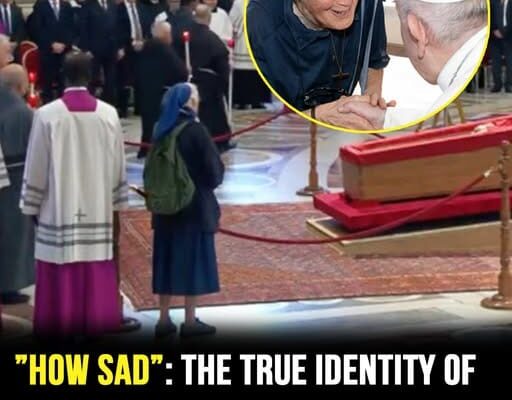The nun who broke protocol at Pope Francis’ coffin

In a moment that transcended the gravity of Vatican tradition, one quiet act of devotion captured hearts across the world.
On April 23, as thousands of mourners poured into St. Peter’s Basilica to say their final goodbyes to Pope Francis, one figure quietly stepped out of line.
She wasn’t a political leader or a dignitary, but rather an 81-year-old nun — Sister Geneviève Jeanningros. And she wasn’t merely there to pay her respects.
The image of Sister Jeanningros, standing in solemn silence beside the Pope’s casket, her eyes glistening with tears, and a green backpack casually slung over her shoulder, quickly became a viral symbol of heartfelt reverence. As others adhered to strict Vatican protocol, she lingered — breaking formation, but never her faith. Pope Francis, born Jorge Mario Bergoglio, passed away on Easter Monday, April 21, at the age of 88 after suffering a stroke, the Vatican confirmed.
Within 24 hours, more than 48,000 people had visited his coffin. Yet none made as lasting an impression as Sister Jeanningros.
Though her name might not be widely recognized, her connection to the late pontiff runs deep. The two first crossed paths more than four decades ago when Francis was Archbishop of Buenos Aires.
Both were deeply committed to serving society’s forgotten — from homeless individuals and transgender people to circus performers and the terminally ill. Their bond, rooted in shared values and mutual respect, remained unshaken, even after Bergoglio ascended to the papacy.
“That’s genuine pain,” one viewer commented after witnessing the video of Sister Jeanningros quietly weeping by the Pope’s casket. “This is a historic moment.”
Lives in a Humble Caravan
Born in France and raised in Argentina, Sister Jeanningros is a member of the Little Sisters of Jesus, an order dedicated to living alongside and serving marginalized communities. For years, she and her fellow nun, Sister Anna Amelia Giachetto, have resided in a modest caravan on the outskirts of Rome, ministering to society’s most neglected.
Every Wednesday, Sister Jeanningros would visit Pope Francis, often bringing people from the streets to meet him. True to his humble nature, the Pope always greeted them warmly. On many occasions, he would invite them to stay for lunch, treating them with the same compassion he extended to all.

She was no stranger to loss. Her aunt, Léonie Duquet, a French nun, was tragically abducted and murdered by Argentina’s military dictatorship during the Dirty War.
Pope Francis, the son of Italian immigrants in Argentina, understood her grief deeply — and stood by her through it all.
Love Over Protocol
Many initially thought that Sister Jeanningros had defied Vatican protocol by stepping out of line to approach the Pope’s coffin. In reality, she had been quietly granted special permission — a rare honor not even extended to cardinals or heads of state, but to someone whose bond with the Pope transcended titles.
In photos, Sister Jeanningros appears among the crowds, unassuming in a simple outfit with a backpack. Yet, in that moment by the coffin, she embodied something much deeper: a life of quiet devotion, a friendship founded not on politics but on a shared purpose.
One particularly poignant image captures the Pope and Sister Jeanningros smiling together at an outdoor event, their joy radiating. In another, they bless a statue at a circus-themed festival — both lovers of the circus, they believed in its power to uplift and inspire.
Her final visit to the Vatican this week was not routine. It was a goodbye. “She approached her friend just like she did every other Wednesday,” one observer wrote. “But this time, the encounter was different. She had come to say farewell, hoping to reunite with him in eternal life.”
In a Church often criticized for its rigidity, Sister Jeanningros and Pope Francis stood for something gentler: inclusion, mercy, and hands-on ministry. Her farewell wasn’t flashy — it didn’t need to be. It was quiet, raw, and deeply human, much like the man she came to mourn.
As her image continues to spread across the internet, one thing becomes clear: sometimes, the most powerful eulogies aren’t spoken, they’re felt — through presence.



